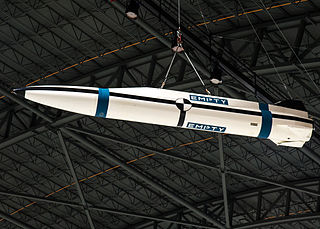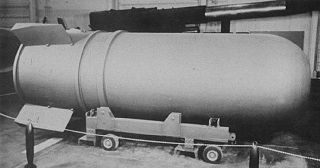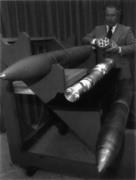
A nuclear bunker buster, also known as an earth-penetrating weapon (EPW), is the nuclear equivalent of the conventional bunker buster. The non-nuclear component of the weapon is designed to penetrate soil, rock, or concrete to deliver a nuclear warhead to an underground target. These weapons would be used to destroy hardened, underground military bunkers or other below-ground facilities. An underground explosion releases a larger fraction of its energy into the ground, compared to a surface burst or air burst explosion at or above the surface, and so can destroy an underground target using a lower explosive yield. This in turn could lead to a reduced amount of radioactive fallout. However, it is unlikely that the explosion would be completely contained underground. As a result, significant amounts of rock and soil would be rendered radioactive and lofted as dust or vapor into the atmosphere, generating significant fallout.
A bunker buster is a type of munition that is designed to penetrate hardened targets or targets buried deep underground, such as military bunkers.

The B83 is a variable-yield thermonuclear gravity bomb developed by the United States in the late 1970s that entered service in 1983. With a maximum yield of 1.2 megatonnes of TNT (5.0 PJ), it has been the most powerful nuclear weapon in the United States nuclear arsenal since October 25, 2011 after retirement of the B53. It was designed by Lawrence Livermore National Laboratory.

The B61 nuclear bomb is the primary thermonuclear gravity bomb in the United States Enduring Stockpile following the end of the Cold War. It is a low to intermediate-yield strategic and tactical nuclear weapon featuring a two-stage radiation implosion design.

The AGM-131 SRAM II was a nuclear air-to-surface missile intended as a replacement for the AGM-69 SRAM. The solid-fueled missile was to be dropped from a B-1B Lancer, carry the W89 warhead and have a range of 400 km. However, the program was canceled by President George H. W. Bush for geopolitical reasons just as the first flight-test missile was delivered.

The B-41 was a thermonuclear weapon deployed by the United States Strategic Air Command in the early 1960s. It was the most powerful nuclear bomb ever developed by the United States, with a maximum yield of 25 megatons of TNT. A top secret document, states “The US has stockpiled bombs of 9 MT and 23 MT...” which would likely be referring to the B-41's actual yield(s). The B-41 was the only three-stage thermonuclear weapon fielded by the U.S.

The W80 is a low to intermediate yield two-stage thermonuclear warhead deployed by the U.S. enduring stockpile with a variable yield ("dial-a-yield") of 5 or 150 kilotonnes of TNT.

The W85 was a thermonuclear warhead developed by the United States of America to arm the Pershing II missile. It was a variable yield device with a selectable yield of 0.3, 5, 10 or 80 kilotonnes of TNT.

The explosive yield of a nuclear weapon is the amount of energy released such as blast, thermal, and nuclear radiation, when that particular nuclear weapon is detonated, usually expressed as a TNT equivalent (the standardized equivalent mass of trinitrotoluene which, if detonated, would produce the same energy discharge), either in kilotonnes (kt—thousands of tonnes of TNT), in megatonnes (Mt—millions of tonnes of TNT), or sometimes in terajoules (TJ). An explosive yield of one terajoule is equal to 0.239 kilotonnes of TNT. Because the accuracy of any measurement of the energy released by TNT has always been problematic, the conventional definition is that one kilotonne of TNT is held simply to be equivalent to 1012 calories.
W70 was a two-stage, thermonuclear warhead that was developed for the MGM-52 Lance missile by the United States. Designed by Lawrence Livermore National Laboratory, the Mod 1 and Mod 2 version of the weapon entered service in 1973, while the enhanced radiation Mod 3 weapon entered service in 1981. The last W70 warhead was dismantled in February 1996.

Medium Atomic Demolition Munition (MADM) was a tactical nuclear weapon developed by the United States during the Cold War. It was an atomic demolition munition (ADM), a combat engineering device for demolition of structures and for battlefield shaping. The device contained a W45 warhead with an estimated yield of 0.5 to 15 kilotonnes of TNT. Each MADM weighed 391 pounds (177 kg) in its transportation container. They were deployed between 1962 and 1986.

The W50 was an American thermonuclear warhead deployed on the MGM-31 Pershing theater ballistic missile. Initially developed for the LIM-49 Nike Zeus anti-ballistic missile, this application was cancelled before deployment. The W50 was developed by Los Alamos National Laboratory. The W50 was manufactured from 1963 through 1965, with a total of 280 being produced. They were retired from service starting in 1973 with the last units retired in 1991.

The W84 is an American thermonuclear warhead initially designed for use on the BGM-109G Gryphon Ground Launched Cruise Missile (GLCM).

The W68 warhead was the warhead used on the UGM-73 Poseidon SLBM missile. It was developed in the late 1960s at Lawrence Livermore National Laboratory.

The W56 was an American thermonuclear warhead produced starting in 1963 which saw service until 1993, on the Minuteman I and II ICBMs.

The W58 was an American thermonuclear warhead used on the Polaris A-3 submarine-launched ballistic missile. Three W58 warheads were fitted as multiple warheads on each Polaris A-3 missile.

The W59 was an American thermonuclear warhead used on some Minuteman I ICBM missiles from 1962 to 1969, and planned to be used on the cancelled GAM-87 Skybolt air-launched ballistic missile.

The W91 was an American thermonuclear warhead intended for use on the SRAM-T variant of the AGM-131 SRAM II air to ground missile.
The B61 Family is a series of nuclear weapons based on the B61 nuclear bomb.
The Mark 27 nuclear bomb and closely related W27 warhead were two American thermonuclear bomb designs from the late 1950s.



















